Several Bird Species Feed in a Certain Species of Tree
Abstract
A study was conducted to determine the species composition, density and feeding guild of birds at Tasik Kenyir and Setiu, Terengganu between June and September 2017 using line transect method. Observations of birds at Tasik Kenyir and Setiu recorded a total of 297 individuals consisting of 26 families from 64 species. This study estimated that the diversity of birds at Tasik Kenyir (H' = 3.6) was higher compared to Setiu (H' = 2.9). However, the density of birds at Setiu (52.05 ± 9.09 SE individuals/ha) was higher than Tasik Kenyir (37.56 ± 10.28 SE individuals/ha). Ten feeding guilds of birds were identified in this study; insectivore, nectarivore, frugivore, omnivore, carnivore, granivore, insectivore-nectarivore, insectivore-frugivore, insectivore-granivore and frugivore-granivore. This study has provided valuable information on the bird assemblage and the understanding on the distribution of birds at Tasik Kenyir and Setiu. It is highly recommended that further studies to be conducted at both sites with more sampling efforts in order to gain a more comprehensive baseline datasets for monitoring bird population trends and turnover between habitats.
Introduction
Birds are one of the vertebrates that are very important in ecosystems where they play crucial roles in ecosystems such as seed dispersal agents, pollinators, browsers, and predators (Peh et al. 2005). Important parameters are used to understand the dynamics of bird population such as species richness, evenness, abundance, diversity and density. Bird density which resembles the population size of each bird species per hectare could be a tool to indicate the bird assemblages, population trends, and the current habitat status (Zakaria and Rajpar 2013). The study of bird feeding guilds is also essential to understand the complexity of forest ecosystem structure and the bird species composition in the forests.
According to Zakaria et al. (2014), species that depend on resources that are available in forest interior are known as interior-specialist species. Additionally, forest-edge specialists are the birds that are able to tolerate and utilize the edge habitats. According to Sodhi et al. (2004), insectivorous birds are more strongly affected by forest fragmentation than other feeding guilds. This situation is due to that most insectivorous bird species are interior-specialists, which depend on food supply in forest interior and they are very sensitive to edge effects (Zakaria et al. 2014).
The undisturbed forest habitat is really important in helping to provide protection especially to forest-dependent birds (Nor Hashim and Ramli 2013). However, currently, tropical lowland dipterocarp forests are facing huge destruction due to anthropogenic activities which lead to the declining of tropical rainforest cover (Gogoi and Sahoo 2018). Forest disturbance due to human activities such as logging will affect the bird species composition in lowland dipterocarp forest, especially bark foragers that are sensitive to logging activity (Styring and Ickes 2001).
This study was conducted at two lowland dipterocarp forests near Saok Waterfalls, Tasik Kenyir and Peladang Agro Resort, Setiu, Terengganu. Both of these lowland dipterocarp forests are well known as tourist attractions due to their richness in biodiversity. While Tasik Kenyir comprises isolated patches of lowland dipterocarp forests, the forest area in Setiu is facing huge destruction due to recreational activities, resorts and land conversion into oil palm plantation (Ahmad 2013). Previous studies conducted at both sites did not include bird density estimation and feeding guilds in their studies (David et al. 2017, 2019; Nelson et al. 2018; Shafie et al. 2018; Omar et al. 2019; Ramlee et al. 2020; Mohd Azmir et al. 2021). Thus, this study aims to provide new information on the species composition, density and feeding guilds of birds at Tasik Kenyir and Setiu, Terengganu.
Materials and methods
Site description
This study was conducted between June and September 2017. Two study sites were selected i.e. lowland dipterocarp forests near Saok Waterfalls, Tasik Kenyir (N05º00′35.8″, E102º39′01.2″) and Peladang Agro Resort, Setiu (N05º35′34.44″, E102º40′46.92″), Terengganu (Fig. 1). Tasik Kenyir in Terengganu is known as the largest man-made lake in South-east Asia (Yong et al. 2011). Tasik Kenyir has 340 islands which were originally hills or highlands that have been submerged by water. These patches of islands formed have made lowland dipterocarp forests in Tasik Kenyir to be isolated. Saok Waterfall is one of the main attractions of ecotourism in Tasik Kenyir and this area is surrounded by lowland dipterocarp forests. Meanwhile, Peladang Agro Resort, Setiu is located in the northern Kuala Terengganu. The lowland dipterocarp forest in Setiu has been exposed to anthropogenic activities mainly due to the development of infrastructure and also the land conversion into oil palm plantation. All of these activities will lead to the loss of forest interior, and edge habitat will increase as a result of forest fragmentation.
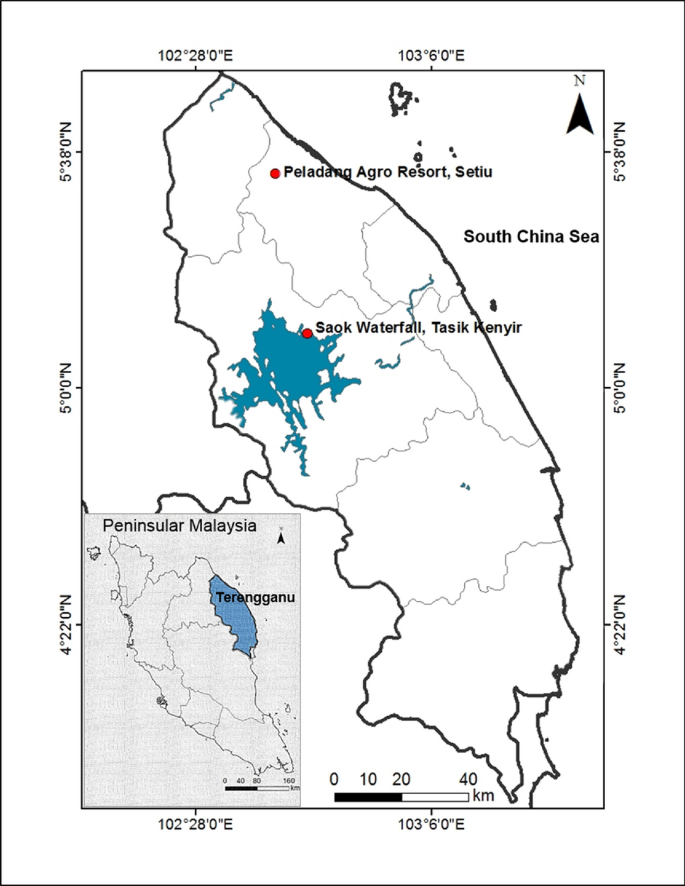
Schematic map showing the study sites at forested areas near Saok Waterfalls, Tasik Kenyir and Peladang Agro Resort, Setiu, Terengganu
Sampling methods
Line transect
Spatial and temporal bird surveys were conducted for ten sessions between June and September 2017 for both study sites. Birds were observed by a single experienced observer along the line transect for one kilometre beginning from the forest edge into forest interior. In line transect sampling, it is assumed that the line transects are placed independently of the animal population so that the animals are distributed uniformly in distance from the lines (Jang and Loh 2010). This study was conducted in early morning from 0730 to 1030 h (Zakaria et al. 2014) and late evening from 1530 to 1830 h (Gumal et al. 2008). Observations were made using a pair of binoculars (Bushnell 7 × 42 waterproof). For each bird encountered, measurements of sighting distance (x) and sighting angle (Ө) were recorded using compass (Sunnto KB-14/360R) to calculate the perpendicular distance (d) using:
$${\text{d }} = x \, sin \, \theta$$
The bird identification was done based on Davison and Chew (2003) and McAfee (2017). During the identification, the birds were assigned to a type of feeding guild based on their preferred diet (Nor Hashim and Ramli 2013). However, if it is not available, the birds were grouped into a feeding guild according to observations of foraging and dietary information provided by Wells (2007).
Data analysis
PAST software (Paleontological Statistics) was used to construct rarefaction curve and calculate diversity indices for both sampling sites. We analyzed line transect data using DISTANCE v.6.0 software (Thomas et al. 2010) and we modelled detection function using a half-normal key with cosine adjustments. We chose this function since the half-normal gave the density estimate closest to the true value (Jang and Loh 2010). The density estimation of birds at Tasik Kenyir and Setiu was obtained using the following equation:
$$D = \frac{n}{{2wLP_{a} }} \times 10000 = {\text{individuals/ha}},$$
where D is density, n = sample size (number of birds observed), w = half the effective transect width (m) where the distances exceeding w either are not recorded or are truncated before analysis, L = total length of line transect (m), Pa = probability that a randomly selected object in the surveyed area a is detected. T-test was conducted to test the difference for density of birds at both sites. T-test was performed using IBM SPSS Statistics version 20.0.
Results
Species composition and density estimation
Observations of birds at Tasik Kenyir and Setiu recorded a total of 297 individuals consisting of 26 families from 64 species of birds (Table 1). There were 149 individuals of birds belonging to 23 families and 48 species recorded at Tasik Kenyir. Meanwhile, in Setiu, 148 individuals of birds from 35 species and 18 families were recorded. For Tasik Kenyir, the most dominant species were Pycnonotus simplex (8.05%), followed by Rhaphidura leucopygialis and Hemiprocne comata (6.71% respectively). Hemiprocne comata was usually observed perching on branches of tall trees and sallying frequently in either large flock or individually. Meanwhile, for Setiu, the most dominant bird species recorded were Hirundo rustica (19.59%) followed by Passer montanus (16.89%) and Copsychus saularis (6.76%) or also known as Murai Kampung. Appendix A shows some of the bird species that were observed in both study sites.
The results of Shannon's diversity index, Simpson's diversity index, and evenness (Table 2) indicate that the diversity and evenness at Tasik Kenyir was higher compared to Setiu.
The bird density at Tasik Kenyir was estimated at 37.56 ± 10.28 SE individuals ha−1 in the range between 8.53 and 165.66 birds ha−1 at 95% confidence interval. Meanwhile, the bird density estimation in Setiu was 52.05 ± 9.09 SE individuals ha−1 and from 34.70 to 78.07 birds ha−1 at 95% confidence interval. From this data, it shows that Setiu has higher density estimation compared to Tasik Kenyir.
Figure 2 shows the rarefaction curves of bird species recorded in Tasik Kenyir and Setiu. Rarefaction curves at both sites showed a gradual increase during early sampling. However, the curve fails to reach asymptotic which indicates that there are many bird species to be sampled if samplings will be continued. As the number of individuals observed increases, more common species are likely to be recorded during the early part of the sampling, hence increasing the recorded species. However, after a certain stage, rarefaction curves at both sites slowly increased indicating that there are only rare species to be sampled. Thus, more sampling efforts need to be done to record all species in both sites. Based on the rarefied abundance value, the 95% CI of the two curves (Fig. 2) do not overlapped indicating that the species richness and abundance of the two communities are significantly different.
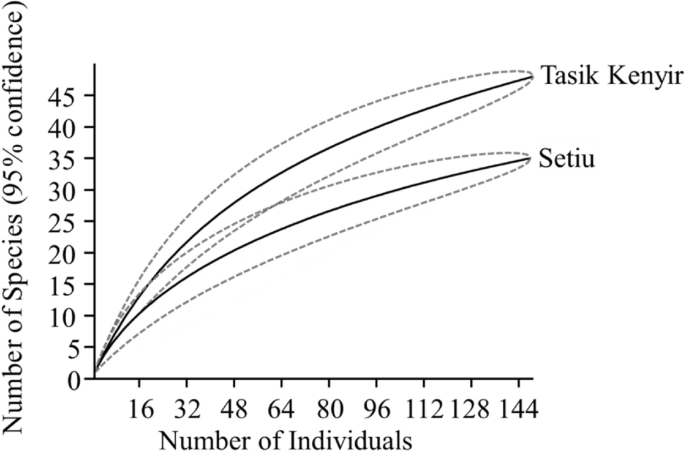
Rarefaction curves (plus (95% CI, dashed lines)) of bird species at Tasik Kenyir and Setiu, Terengganu
Feeding guilds
In this study, birds from ten feeding guilds were identified; insectivore, nectarivore, frugivore, omnivore, carnivore, granivore, insectivore-nectarivore, insectivore-frugivore, insectivore-granivore and frugivore-granivore (Fig. 3). Tasik Kenyir was dominated by bird species from insectivore (45.83%) followed by frugivore (22.92%) and insectivore-frugivore (12.50%). Granivore, insectivore-nectarivore, insectivore-granivore and frugivore-granivore (2.08% each) were the least feeding guilds recorded at Tasik Kenyir. Meanwhile, no carnivorous species were observed at Tasik Kenyir. For Setiu, insectivorous species (40.00%) was the most dominant species followed by frugivore (17.14%), insectivore-frugivore (14.29%), and insectivore-nectarivore (11.43%) species. The rarest guilds recorded at Setiu were nectarivore, carnivore, granivore and insectivore-granivore (2.86%) and frugivore-granivore was absent in Setiu.
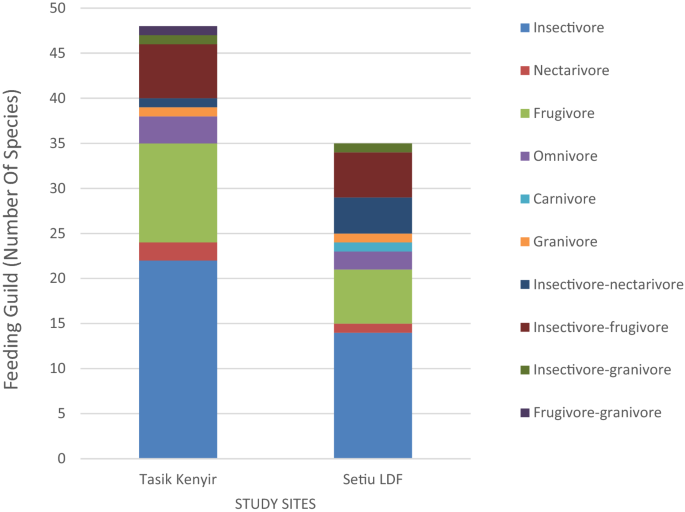
Number of bird species according to feeding guilds at Tasik Kenyir and Setiu
Discussion
Species composition and density estimation
Tasik Kenyir consists of many patches of island provide suitable habitat for many species of birds with more than 230 species were recorded in this area (Sulaiman et al. 2015). The presence of nine hornbill species from a total of ten species that occurred in Peninsular Malaysia has made this area special (Sharoum et al. 2015; McAfee 2017). This present study has recorded five species of hornbills at Tasik Kenyir. Four species of vulnerable (IUCN 2018) hornbills were Buceros bicornis (Great Hornbill) with seven observations, Anthracoceros malayanus (Black Hornbill) with four observations, Buceros rhinoceros (Rhinoceros Hornbill) with two observations and Aceros subruficollis (Plain-pouched Hornbill) with only one observation. Another species was the near threatened (IUCN 2018) hornbill, Anorrhinus galeritus (Bushy-crested Hornbill) with only one observation.
Meanwhile in Setiu, three species of hornbills were observed; A. galeritus with eight observations, B. bicornis and A. comatus with three observations each. The presence of A. comatus which inhabit understorey level of lowland dipterocarp forest indicates that Setiu provides the habitat requirement for this omnivorous hornbill. For instance, there are abundance of fruiting trees of Ficus sp. (Appendix B) observed in this area. Besides that, A. comatus also has been found foraging for a food source in oil palm plantation that is located near to the forest. This result shows that although some of the areas in Setiu have been converted into oil palm plantation, it is still being an important habitat for certain species of birds, especially that are able to adapt in disturbed areas.
The results of the present study indicated that the diversity of bird species at Tasik Kenyir is higher compared to Setiu. We presumed it was due to the forest vegetation structure in this area. Dense forest vegetation with complex structure could provide high diversity of food sources specifically for different species of birds (Charbonnier et al. 2016). In addition, there were a lot of fruiting trees and shrubs observed along the transect trail at Tasik Kenyir compared to Setiu, including Macaranga gigantea, Muntingia calabura, Melastoma malabathricum and Musa sp. (Appendix C). Meanwhile, the lower diversity of birds in Setiu is probably due to higher human disturbance in this area compared to Tasik Kenyir, which is a gazetted area for a reserved forest. The presence of anthropogenic activities such as resorts and land conversion into oil palm plantation contribute to the low diversity of bird in this area (Appendix D). This result was parallel to other previous studies that have indicated low diversity of birds in an agriculture area such as oil palm plantation (Koh 2008; Edwards et al. 2010; Azman et al. 2011). According to Edwards et al. (2013), the reduction of the resources in agricultural system such as oil palm plantation caused the limitation in food source for birds.
Setiu which was more disturbed, nonetheless in this study, had higher bird density compared to Tasik Kenyir. Similarly, the insectivorous bird density in Ayer Hitam Forest Reserve, an isolated patch of lowland dipterocarp forest which is surrounded by anthropogenic activities was highest at the point closest to the disturbance with 22.31 ± 5.52 individuals ha−1 (Moradi et al. 2009). Willemoes et al. (2018) also found that, the density of certain species of birds was 2.5 times higher in a forested area heavily disturbed by agricultural activities than in forested area with no agriculture. However, based on previous studies, the density of birds may varied according to many other factors including forest types, sampling season, habitat heterogeneity and also the surrounding landscape (Naugle et al. 1999; Petit et al. 1999; Lencinas et al. 2005).
Feeding guilds
Tasik Kenyir and Setiu were dominated by insectivorous species except for P. simplex which is frugivore and P. montanus which is insectivore-granivore. Azman et al. (2011) and David (2014) also recorded C. saularis as one of the most dominant species in their studies. This edge-specialist species can adapt to edge habitat and able to tolerate with shrub cover and light intensity (Varasteh Moradi et al. 2013). Both H. rustica and C. saularis are insectivorous species and they are expert in foraging insects in oil palm plantation (David 2014).
The feeding guilds recorded in Setiu were primarily insectivore, granivore, carnivore, insectivore-frugivore, insectivore-nectarivore and insectivore-granivore. This result is similar with the study by Azman et al. (2011) that recorded insectivore, granivore, carnivore, insectivore-frugivore, and insectivore-nectarivore in their study. However, no observation of insectivore-granivore birds was recognized by Azman et al. (2011) in oil palm plantation. In present study, most of the feeding guilds were decreased in number except for insectivore-nectarivore species increased as the forest areas in Setiu were converted into oil palm plantation. This result is parallel to other previous studies that found land conversion into oil palm plantation significantly decreased the abundance of insectivore, frugivore, insectivore-frugivore (Gray et al. 2007; Azman et al. 2011). The carnivorous bird species was found to occur only in Setiu, but not in Tasik Kenyir. Setiu has more open areas compared to Tasik Kenyir and the presence of oil palm plantations increased the availability of prey for carnivorous bird species in this area. Centropus sinensis (Greater Coucal) which is a carnivorous species was found foraging for a food source in oil palm plantation in Setiu. Prey species such as small mammals, reptiles and amphibians are among the food sources that available in oil palm plantation area (Shafie et al. 2011; Paoletti et al. 2018; Scriven et al. 2018).
The canopy cover in the forest of Tasik Kenyir is highly thick and dense. This condition provide favourable hiding places for birds' preys such as lizards, rodents and frogs (Wells 1999). The preys such as lizard and frog have the special adaptation to camouflage, making themselves invisible towards predators including carnivorous birds (Marshall et al. 2015; Blanchette et al. 2017). In addition, dense canopy cover decreases the probability to detect carnivorous bird species in this area. Thus, no carnivorous bird species was observed at Tasik Kenyir during this study period. Frugivore-granivore bird species recorded in this study was only Chalcophaps indica (Emerald Dove) which inhabits forest interior of Tasik Kenyir. However, no frugivore-granivore species was observed at Setiu. This is most probably because frugivorous species in this area do not adapt to eat grains as they were mainly inhabit forest interior where abundant of fruits are available. Most of avian species are restricted to forest interior as they are sensitive to edge habitat (Zakaria et al. 2014). In addition, the edge habitat is expected to affect the food availability as well as the frugivorous bird species (Barlow and Peres 2004; Vergara et al. 2010).
Conclusion
In conclusion, Tasik Kenyir recorded higher diversity of bird species compared to Setiu, which is due to the forest vegetation structure that promotes a more suitable site for bird species in this area. However, Setiu which is surrounded by anthropogenic activities making this area as a focal site for birds, thus recorded higher density compared to Tasik Kenyir. Ten feeding guilds were identified at both sites; insectivore, nectarivore, frugivore, omnivore, carnivore, granivore, insectivore-nectarivore, insectivore-frugivore, insectivore-granivore and frugivore-granivore. There was no carnivorous bird species observed at Tasik Kenyir due to the canopy cover, while no frugivore-granivore species was observed at Setiu due to fruit availability. In this study, feeding guilds were identified based on birds' diets information. Therefore, it is recommended in future studies, other methods would also be used to determine the feeding guilds of bird species such as by observing their foraging behaviour during the sampling period.
References
-
Ahmad R (2013) Cultural landscapes as heritage in Malaysia: Potentials, threats, and current practices. PhD Dissertation. Utrecht University, Utrecht
-
Azman NM, Latip NSA, Sah SAM, Akil MAMM, Shafie NJ, Khairuddin NL (2011) Avian diversity and feeding guilds in a secondary forest, an oil palm plantation and a paddy field in riparian areas of the Kerian River Basin, Perak, Malaysia. Trop Life Sci Res 22(2):45–64
-
Barlow J, Peres CA (2004) Avifaunal responses to single and recurrent wildfires in Amazonian forests. Ecol Appl 14(5):1358–1373
-
Blanchette A, Becza N, Saporito RA (2017) Escape behaviour of aposematic (Oophaga pumilio) and cryptic (Craugastor sp.) frogs in response to simulated predator approach. J Trop Ecol 33(2):165–169
-
Charbonnier YM, Barbaro L, Barnagaud JY, Ampoorter E, Nezan J, Verheyen K, Jactel H (2016) Bat and bird diversity along independent gradients of latitude and tree composition in European forests. Oecologia 182(2):529–537
-
David G, Roslan A, Pesiu E, Abdullah MT (2019) A Brief Survey on the Birds in Belukar Bukit, Kenyir, Terengganu, Malaysia. Greater Kenyir Landscapes. Springer, Cham, pp 143–157
-
David G, Roslan A, Pesiu E, Salam MR, Abdullah MT, Hamza AA & Clements R (2017) Bird Sanctuary: A Potential Ecotourism Activity In Lake Kenyir, Terengganu. Ecotourism Potentials in Malaysia, 30
-
David G (2014) Density of avifauna in the oil palm plantation and fragmented forest in SAREMAS Oil Palm Plantation, Miri. Undergraduate Dissertation. Universiti Malaysia Sarawak, Malaysia
-
Davison GWH, Chew YF (2003) A photographic guide to birds of Peninsular Malaysia and Singapore. New Holland Publisher, United Kingdom
-
Edwards DP, Hodgson JA, Hamer KC, Mitchell SL, Ahmad AH, Cornell SJ, Wilcove DS (2010) Wildlife-friendly oil palm plantations fail to protect biodiversity effectively. Conserv Lett 3(4):236–242
-
Edwards FA, Edwards DP, Hamer KC, Davies RG (2013) Impacts of logging and conversion of rainforest to oil palm on the functional diversity of birds in Sundaland. Ibis 155(2):313–326
-
Gogoi A, Sahoo UK (2018) Impact of anthropogenic disturbance on species diversity and vegetation structure of a lowland tropical rainforest of eastern Himalaya, India. J Mountain Sci 15(11):2453–2465
-
Gray MA, Baldauf SL, Mayhew PJ, Hill JK (2007) The response of avian feeding guilds to tropical forest disturbance. Conserv Biol 21(1):133–141
-
Gumal M, Hon J, Kong D (2008) Birds and bats of Loagan Bunut National Park Sarawak, Malaysia. In: Peat Swamp Forest Project & Wildlife Conservation Society, pp 105.
-
IUCN (2018) The International Union for Conservation of Nature. https://www.iucnredlist.org/
-
Jang W, Loh JM (2010) Density estimation for grouped data with application to line transect sampling. The Annals of Applied Statistics: 893–915
-
Koh LP (2008) Can oil palm plantations be made more hospitable for forest butterflies and birds? J Appl Ecol 45(4):1002–1009
-
Lencinas MV, Pastur GM, Medina M, Busso C (2005) Richness and density of birds in timber Nothofagus pumilio forests and their unproductive associated environments. Biodivers Conserv 14(10):2299–2320
-
Marshall KL, Philpot KE, Damas-Moreira I, Stevens M (2015) Intraspecific colour variation among lizards in distinct island environments enhances local camouflage. PLoS One 10(9):1–20
-
McAfee A (2017) Birds of Terengganu. Penerbit Universiti Sultan Zainal Abidin
-
Mohd Azmir KN, Mohamad Aman MA, Abd. Rahmat MR, Yahya NFA, Samsuddin N, Ahmad Tarmizi NFL, Jusof NFW, Kamaruddin NF, Basri HH, Ariffin MSA, Marni W, Zahidin MA, Mat-Ghani SNA, Edinur HA & Abdullah MT (2021) Assessment of Tanjung Bewah karst at Tasik Kenyir and construction of a framework for high value biodiversity area. Malayan Nat J 73(4): 459-468
-
Moradi HV, Zakaria M, Mohd AB, Yusof E (2009) Insectivorous birds and environmental factors across an edge-interior gradient in tropical rainforest of Malaysia. Int J Zool Res 5(1):27–41
-
Naugle DE, Higgins KF, Nusser SM, Johnson WC (1999) Scale-dependent habitat use in three species of prairie wetland birds. Landscape Ecol 14(3):267–276
-
Nelson BR, David G, Mokhtar AF, Mamat MA, Rahman AJA (2018) Avian data from Kenyir rainforest trail. Data Brief 21:2633–2637
-
Nor Hashim E, Ramli R (2013) Comparative study of understorey birds diversity inhabiting lowland rainforest virgin jungle reserve and regenerated forest. Scientific World J 2013:1–7
-
Omar NI, Latif MA, Shamsul N, Katullah MIS, Basri HH, Mazlan AA, Ismail NA (2019) Rapid Assessment and Taxonomic Checklist of Vertebrates at the Foot of Gunung Tebu Forest Reserve, Terengganu. Greater Kenyir Landscapes. Springer, Cham, pp 201–217
-
Paoletti A, Darras K, Jayanto H, Grass I, Kusrini M, Tscharntke T (2018) Amphibian and reptile communities of upland and riparian sites across Indonesian oil palm, rubber and forest. Glob Ecol Conserv 16:e00492
-
Peh KSH, de Jong J, Sodhi NS, Lim SLH, Yap CAM (2005) Lowland rainforest avifauna and human disturbance: persistence of primary forest birds in selectively logged forests and mixed-rural habitats of southern Peninsular Malaysia. Biol Cons 123(4):489–505
-
Petit LJ, Petit DR, Christian DG, Powell HD (1999) Bird communities of natural and modified habitats in Panama. Ecography 22(3):292–304
-
Ramlee MNA, Hussin MF, Roslan A, Rosmidi FH, Pesiu E, Rahim NAA, Ahmad NII, David G, Zakaria AA, Adanan NA, Basri HH (2020) Conspectus of flora, fauna and micro-climate data in Tasik Kenyir from Mac 2015–February 2016. Data Brief 29:105328
-
Scriven SA, Gillespie GR, Laimun S, Goossens B (2018) Edge effects of oil palm plantations on tropical anuran communities in Borneo. Biol Cons 220:37–49
-
Shafie NJ, Sah SAM, Latip NSA, Azman NM, Khairuddin NL (2011) Diversity pattern of bats at two contrasting habitat types along Kerian River, Perak, Malaysia. Trop Life Sci Res 22(2):13
-
Shafie NJ, Ahmad A, Ismail NA, David G, Abdullah MT (2018) Bird assemblages in lowland dipterocarp forests of Tasik Kenyir and Setiu, Terengganu. J Sustain Sci Manag 13(2):43–56
-
Sharoum FM, Abdullah MT, Ali CA, Ismail R (2015) Geopark Tasik Kenyir. UMT Publisher, Malaysia, Terenggan
-
Sodhi NS, Liow LH, Bazzaz FA (2004) Avian extinctions from tropical and subtropical forests. Annu Rev Ecol Evol Syst 35(2004):323–345
-
Styring AR, Ickes K (2001) Woodpecker abundance in a logged (40 years ago) vs. unlogged lowland dipterocarp forest in Peninsular Malaysia. J Trop Ecol 17:261–268
-
Sulaiman MH, Embong M, Mamat MA, Tahir NFDA, Latip NA, Murni R, Azhar MIM (2015) Short Note Preliminary Survey of the Bird Assemblage at Tanjong Mentong, Lake Kenyir, Hulu Terengganu, Malaysia. Trop Nat History 15(1):87–90
-
Thomas L, Buckland ST, Rexstad EA, Laake JL, Strindberg S, Hedley SL, Bishop JRB, Marques TA, Burnham KP (2010) Distance software: Design and analysis of distance sampling surveys for estimating population size. J Appl Ecol 47(1):5–14
-
Varasteh Moradi H, Zakaria M, Robinson K, S, (2013) Understorey bird responses to the edge-interior gradient in an isolated tropical rainforest of Malaysia. Environm Resour Res 1(2):203–232
-
Vergara PM, Smith C, Delpiano CA, Orellana I, Gho D, Vazquez I (2010) Frugivory on Persea lingue in temperate Chilean forests: interactions between fruit availability and habitat fragmentation across multiple spatial scales. Oecologia 164(4):981–991
-
Wells DR (1999) The birds of the Thai-Malay Peninsula. London Academic Press, London
-
Wells DR (2007) The birds of the Thai-Malay Peninsula. London Academic Press, London
-
Willemoes M, Tøttrup AP, Lerche-Jørgensen M, Jacobsen EM, Reeve AH, Thorup K (2018) Spatial behaviour and density of three species of long-distance migrants wintering in a disturbed and non-disturbed woodland in northern Ghana. Bird Conserv Int 28(1):59–72
-
Yong DL, Qie L, Sodhi NS, Koh LP, Peh KSH, Lee TM, Lim SLH (2011) Do insectivorous bird communities decline on land-bridge forest islands in Peninsular Malaysia? J Trop Ecol 27(1):1–14
-
Zakaria M, Rajpar MN (2013) Density and diversity of water birds and terrestrial birds in man-made marsh, Malaysia. Sains Malaysiana 42(10):1483–1492
-
Zakaria M, Rajpar MN, Moradi HV, Rosli Z (2014) Comparison of understorey bird species in relation to edge–interior gradient in an isolated tropical rainforest of Malaysia. Environ Dev Sustain 16(2):375–392
Acknowledgements
We thank Department of Wildlife and National Parks (DWNP) Peninsular Malaysia for providing research permits to conduct this study (JPHP&TN(IP):60-4/1.13 Jilid 21 (55)). We would also like to thank Universiti Malaysia Terengganu for providing facilities and transportation during this study period. This study was funded by Trans Disciplinary Research Grant Scheme (TRGS/2014/59373). We thank postgraduate and final year students; Elizabeth Pesiu, Noor Shahirah Mohd Ibrahim, Hasrul Zaman, Salmi Abdullah, Amirul Ashraf Mazlan, Khairul Bariah Mohd Johan and Romanrio Anak Ering for their help and guidance during the sampling and last but not least, the lab assistants; Mr. Razali Salam and Mr. Mazrul Aswady.
Author information
Authors and Affiliations
Corresponding author
Electronic supplementary material
Appendices
Appendix
Appendix A
See below Fig. 4 here.
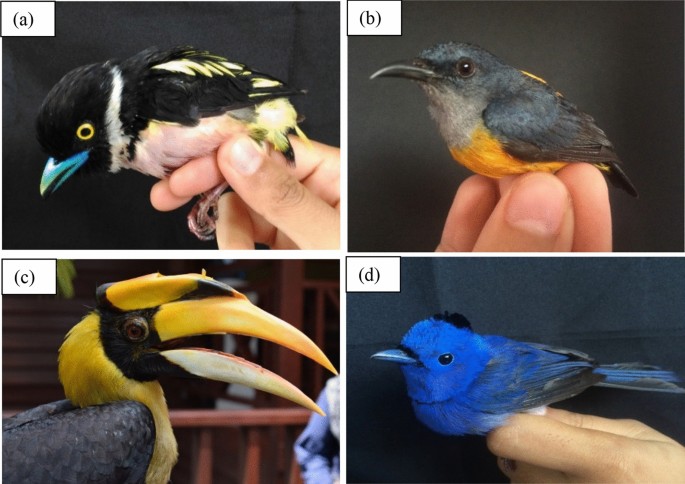
Some of the bird species observed in both study sites; a Black-and-yellow Broadbill, b Orange-bellied Flowerpecker, c Great Hornbill and d Black-naped Monarch
Appendix B
See below Fig. 5 here.
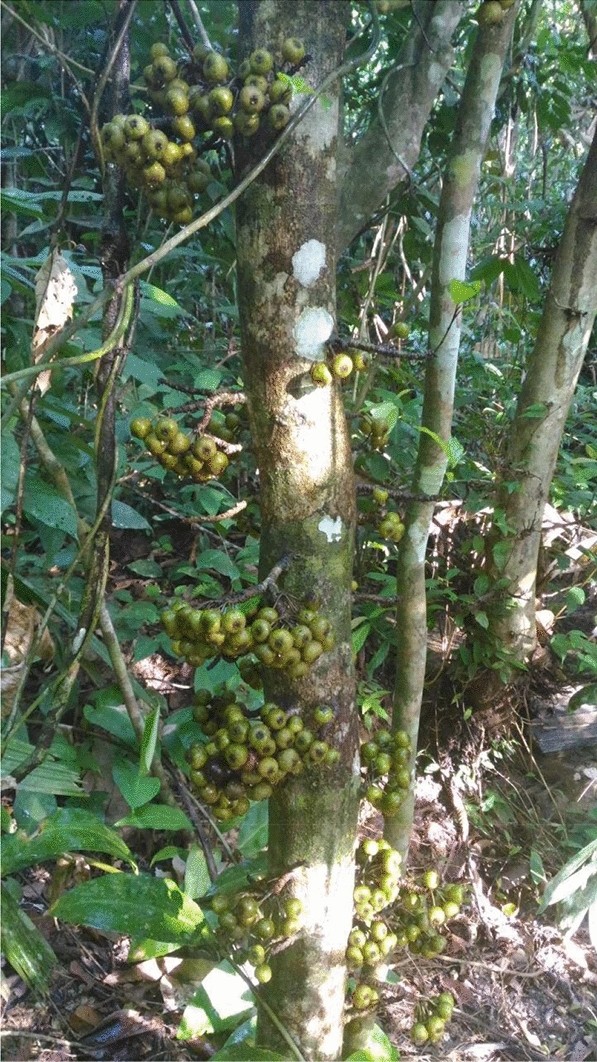
Fruiting trees of Ficus sp. observed in study site in Setiu
Appendix C
See below Fig. 6 here.
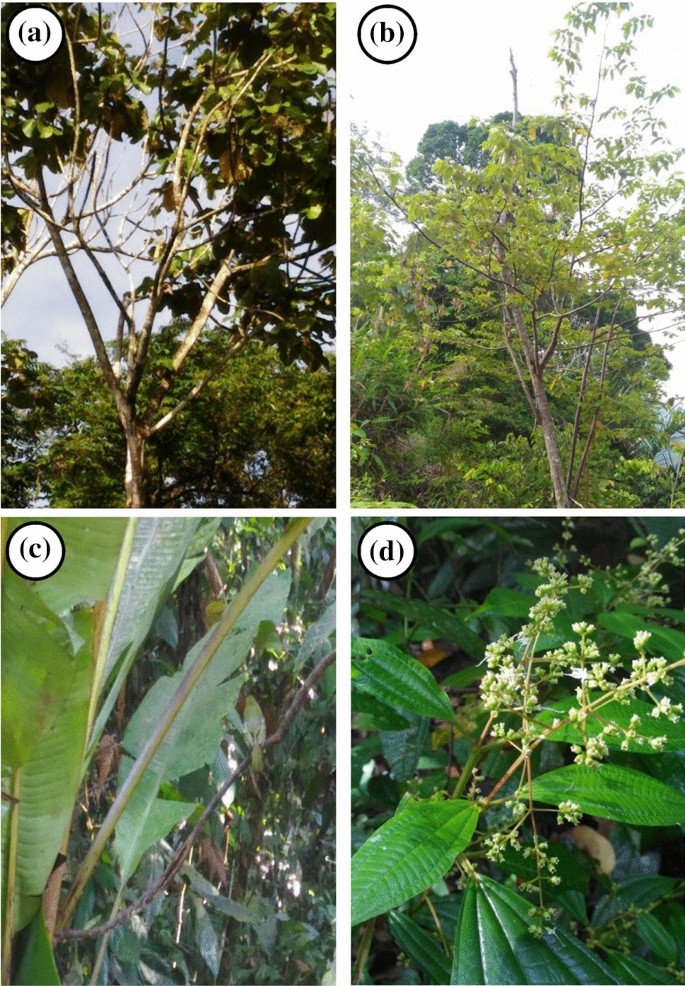
Species of plants found at Tasik Kenyir; a Macaranga gigantea, b Muntingia calabura, c Musa sp. and d Melastoma malabathricum
Appendix D
See below Fig. 7 here.
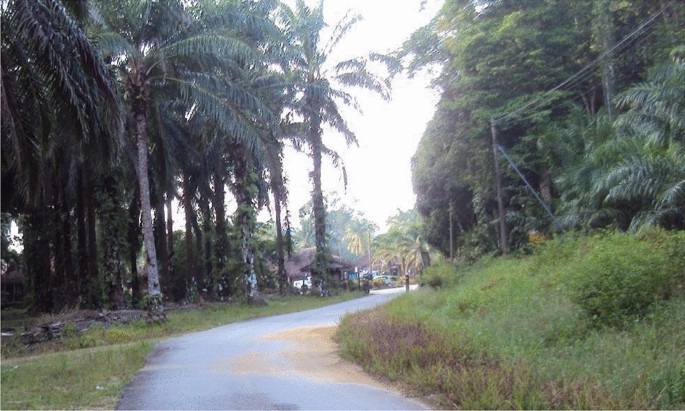
Oil palm plantation area in study site in Setiu
Rights and permissions
Open Access This article is licensed under a Creative Commons Attribution 4.0 International License, which permits use, sharing, adaptation, distribution and reproduction in any medium or format, as long as you give appropriate credit to the original author(s) and the source, provide a link to the Creative Commons licence, and indicate if changes were made. The images or other third party material in this article are included in the article's Creative Commons licence, unless indicated otherwise in a credit line to the material. If material is not included in the article's Creative Commons licence and your intended use is not permitted by statutory regulation or exceeds the permitted use, you will need to obtain permission directly from the copyright holder. To view a copy of this licence, visit http://creativecommons.org/licenses/by/4.0/.
Reprints and Permissions
About this article
Cite this article
Shafie, N.J., Anuar, H., David, G. et al. Bird species composition, density and feeding guilds in contrasting lowland dipterocarp forests of Terengganu, Peninsular Malaysia. Trop Ecol (2022). https://doi.org/10.1007/s42965-022-00267-5
-
Received:
-
Revised:
-
Accepted:
-
Published:
-
DOI : https://doi.org/10.1007/s42965-022-00267-5
Keywords
- Avifauna
- Diversity
- Frugivorous
- Kenyir
- Rarefaction curve
- Setiu
- Species richness
Source: https://link.springer.com/article/10.1007/s42965-022-00267-5
0 Response to "Several Bird Species Feed in a Certain Species of Tree"
Post a Comment